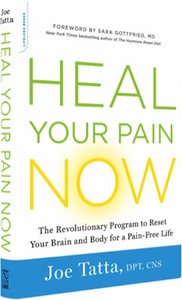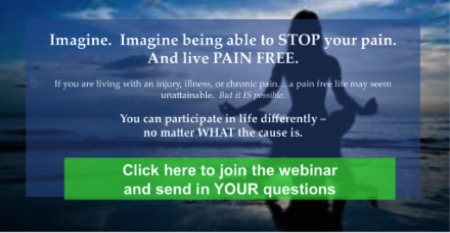
If you struggle with chronic pain from an injury, autoimmune disease, fibromyalgia, joint pain, arthritis, anxiety, depression or have tried everything without success, Heal Your Pain Now provides natural solutions to eliminate pain and return you to a life worth living.
I recently had the pleasure of interviewing Dr. Joe Tatta, physical therapist and nutritionist, author of this wonderful new book and a dear friend!
You can watch the interview here:
And here is a summary from our great interview:
What is chronic pain – it’s about protection. Acute pain like an ankle sprain tells you to rest and heal; chronic pain – persists beyond 3 months and is less about protection and more about the brain being in a hyper-sensitive state.
The human body has innate ability to heal i.e. the body has a natural anti-inflammatory process and tissue will heal in 3 months. After those 3 months it becomes less about the actual tissue and more about what is going on centrally in the brain and nervous system.
Central sensitization or the hyper-sensitive brain: we have a neural signature specific to you and your pain experience.
It’s based on what you believe about pain, are told about pain, your memories, your emotions, input from body (such as tightness), your thoughts, touch and sound.
With central sensitization pathways light up in the brain causing pain and in some instances those pathways never quiet down. The more we can be educated about pain the faster we can release this central sensitization and the pain.
An example: You and I had backpain – my life: mom is a nurse, my backpain comes and goes, I can move a little, I go to work, do some chores and basic exercise; in your life your grandmother had really bad back pain, was in a wheelchair and said back pain is the worst pain you could ever have. This may make your pain persist. Fear causes pain to persist over a long period of time.
Fear and pain: it can be actual fear or perceived; fight or flight – muscles tense around the spinal column; blood is shunted away from the spinal muscles because you’re getting ready to run or fight; when it’s persistent there is no blood flow and no healthy nutrients going to the spinal muscles; cortisol levels become elevated – they are inflammatory and very powerful at laying down memory patterns (which can make pain persist).
When you lessen fear you promote relaxation and in general pain disappears very fast.
When you hear all this the brain repatterns – you’re doing a mini cognitive behavior session just listening to and watching the video of us interacting! (I love this!)
Myth: chronic pain has to be chronic – no! Replace the word chronic with persistent because language is really important for creating these pain memories.
Myth: imaging studies like xrays and MRIs are correlated with pain. Often we see intense pain with normal xrays, sometimes no pain with awful rays.
There is also the emotional aspect – when someone in a white coat holds up that xray and says you have this issue it can start that fear response and the pain can be worse.
This fear pain connection is fascinating and I asked if it common knowledge
- The average physician only receives 4 hours of pain science education in 12 -16 years of education – most of what they learn focused on medications, injections and surgery. We currently have a biomedical model (xray and injection or surgery, injections or medications) but we are moving to a biopsychosocial model (movement, nutrition, mindset, the brain)
- The book has 40 pages of evidence based research (if you’re a practitioner and would like access to the papers let me know in the comments and Dr. Joe can get them to you)
- I suggest using the book to educate yourself and your doctor
Medications prescribed for pain: Opioids (oxycontin, codeine, morphine) #1 drug prescribed for pain. CDC and NIH: You should not prescribe opioids as first line of treatment for chronic pain. They are highly addictive – 3 million addicted to them; 2 million die each year; opioid-induced hyperalgesia – the more you take the more pain sensitivity you have and the more medication is needed.
Side effects: constipation caused by opioids and you’re prescribed medications for the constipation; called OIC (opioid induced constipation) – changes the microbiome, fecal matter is bound up, you get leaky gut, inflammation starts in gut and there are impacts on neurotransmitter production like GABA and serotonin (and then increased anxiety and depression).
Other medications used are SSRIs – depression looks very similar to pain in the brain – when you heal the gut you can balance serotonin
Gabapentin and NSAIDs and benzodiazepines are also prescribed.
The book covers ALL pain – any chronic (or persistent) pain that has been around for 3 months or longer
Nutrition: diet is the #1 way to reduce inflammation – food is medicine approach; 100% whole food (if it comes in a box or a can or is made by man it has no place in your diet especially if you have chronic pain); farm-raised beef, wild fish, fruit and vegetables, healthy fats i.e. a modified Mediterranean diet.
Then use a gut-healing protocol for removing inflammation and addressing autoimmunity – remove gluten, dairy and sugar. In 3-7 days people see their pain decrease from 8/10 to 2/10.
“I don’t think I have arthritis and I don’t think I need this Aleve – I think it was the gluten I was eating”
If you slip a little and have some gluten then you realize you can’t even have any and you’re educating yourself that food is medicine. It’s very powerful
With gut healing, if you have autoimmunity take out eggs and GMOs (soy and corn) too; there is more clinical evidence around nightshades – if you can heal the gut you can often tolerate small amounts.
The ketogenic diet is last phase: 65% – 75% fat, 5% carbs (from fibrous vegetables) and the rest is protein. It’s awesome to regulate blood sugar, helps central sensitization (we know because those with seizures do really well on a ketogenic diet). With seizures glutamate is high and GABA low and the ketogenic diet helps balance out these in your brain and calms the nervous system and decreases pain; upregulates ATP (energy molecule) which helps with pain. Brain fogs goes away.
The ketogenic diet is not for someone with type 1 diabetes, who is pregnant or in acute adrenal fatigue
Do a trial of 3-4 weeks and cycle into ketosis every 4-6 months.
Intermittent fasting tricks body into thinking body is starving.
A big plane flies over at the 41 minute mark! Enjoy the laugh with us!
With intermittent fasting do a 14-16 hour fast overnight, say 6pm to 9am the next day
Mini-fasts: protein shake in the morning or evening – the meal is smaller; or use bone broth – healing for gut and collagen for your joints!
Supplements: omega-3s (2000 to 4000mg); curcumin (in oil – really important to help absorption); vitamin D 5000-10,000 IU; some kind of proteolytic enzymes; GABA for pain and anxiety and central sensitization.
If this feels overwhelming and you feel you need more support (in addition to reading the book) Dr. Joe does have a group program
It’s called Heal your Pain Heal your Life – 6 week process, a Facebook group group, Q and A calls, and social support (which is huge if you have pain and can’t get out of house, or if others can’t relate to your pain, plus for the community support)
Movement, sedentary syndrome, sit rise test: movement is medicine and has to be in your life in some form. Even 5 minutes twice a day can help. It sends signal to your brain “I can move a bit and I’m safe”, you build confidence and fear decreases, releases endorphins, quiets down the nervous system
Sit rise test – cross your legs and lower yourself down to the floor without your hands and then stand back up. It indicates a long life-expectancy; they are not sure why – cardio effects? Balance? It tests strength and vitality; if you can’t do it – practice each day. Third world cultures sit on the floor to communicate – when you move joints in full range it lubricates them.
I’m a climber, skier, mountain biker, windsurfer and have had many injuries and worked with wonderful physical therapist and yet I have learned so much from Dr. Joe and this book! I will use it for prevention of injuries and pain and for the next time I am injured and in pain.
Dr. Joe ended by saying
Keep moving forward, we’re going to change the pain paradigm and give people their lives back!
This is the book summary:
In Heal Your Pain Now, Dr. Joe Tatta teaches you how to regain control of your life by breaking the cycle of persistent pain. Following Dr. Tatta’s program, you learn the role of the brain in pain–and how to use your brain to STOP your pain; how nutrition can eliminate the inflammation in your body, which is exacerbating your pain; and how to overcome Sedentary Syndrome and choose the best movement strategy. Dr. Tatta provides quizzes, self-assessments, meal plans, shopping lists, recipes, and exercises to support you throughout the program.
As I mentioned in the interview I really appreciate the very unique perspective Dr. Joe brings to healing from pain. His expertise from the physical therapy and movement world is so beautifully meshed with the power of nutrition! He covers the foundational information for eating an anti-inflammatory diet, an excellent gut healing protocol, healing supplements and with much fascinating reading on intermittent fasting and the ketogenic diet.
Dr. Joe explains these concepts brilliantly: the brain in pain, central sensitization, myths around pain and the biospychosocial model of pain. With the work that I do with anxious women like you (and men too), the pain connection to fear is very relevant; and the fact that stress, anxiety, post-traumatic stress disorder (PTSD), or depression are danger signals that can actually make the pain worse depending on how “sensitive” your nervous system has become.
Also, since many of the same pain medications are also often prescribed for anxiety, this book is a wonderful resource for someone with both pain and anxiety. But best of all, this book offers real solutions for everyone suffering from any kind of pain, and a solid understanding of the mechanisms.
I’m sure you’d like access to what we talked about during the interview:
- Joe’s Pain Quiz
- His 6 week group program Heal your Pain heal your Life
- You can order the book Heal Your Pain Now from Amazon and get access to some bonus gifts here
- I forgot to mention that Dr. Joe has live Q and A webinar coming up on February 22, 2017 at 7pm EST and you can register for that here so that you know exactly how to heal without medication, injections or surgery. There is new science to end – or dramatically reduce your pain.
Please let us know which parts of this really resonated with you and what you’re looking forward to implementing for your pain.





